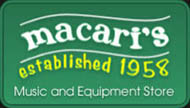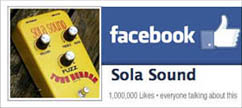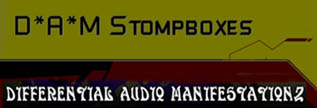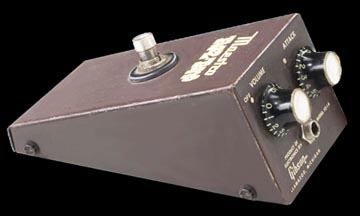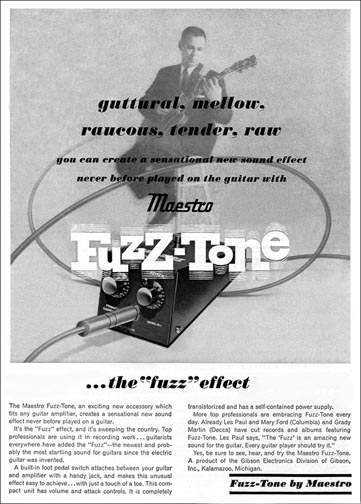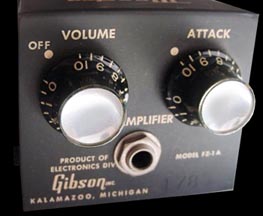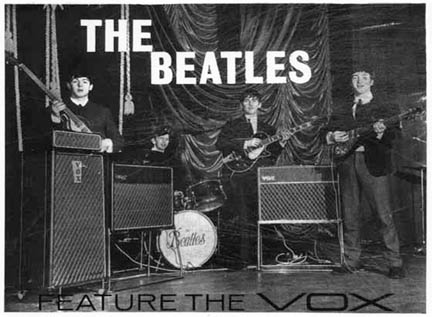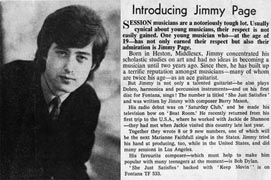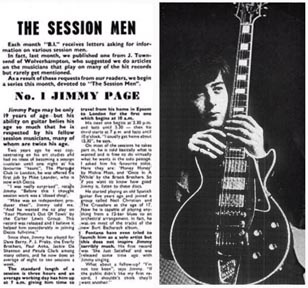The Tone Bender Timeline
VISIT MY SWORDS, KNIVES and FANTASY ART WEBSITE www.kitrae.net
This page is periodically updated to reflect new information. Do not reprint or repost without permission.
©2009 Kit Rae. Last update October 2015.

WHAT IS A TONE BENDER? - The Tone Bender was one of the first fuzz tone boxes to come out of England during the booming London music scene in the mid 1960's - the British answer to the American Maestro Fuzz-Tone made by Gibson. There are numerous versions, each with different circuits and different characteristics to the sound, and numerous re branded versions made for third party companies, and numerous clones. Tone Benders were popular pedals among guitarists in the late 1960's through the mid 1970's. They are often associated with the Vox brand, and guitarists like Jimmy Page, Jeff beck, Mick Ronson, and Pete Townshend. They are arguably the pedals with the most interesting and colourful history in the annals of fuzz, and the genesis of the UK stomp box phenomenon. The history is somewhat convoluted, with a host of interrelated individuals and companies, including Jennings Musical Industries, Vox, JMI/Vox engineers Dick Denney and Gary Hurst, the legendary Macaris Music Exchange of London, Sola Sound/Colorsound, The Beatles, The Yardbirds, and Led Zeppelin, among others.
Below is a chronological timeline of the pertinent dates for pedal releases, events, and people related to the Tone Bender fuzz pedals, spanning the 1960s, and including some dates from the 50s, 70s, and 90s that are relevant. What began as a simple release date timeline for the American Electro-Harmonix Big Muff Pi turned into a broader Fuzz and Muff Pedal Timeline, which in turn got me looking at the history of the American Gibson Maestro Fuzz-Tone, its many clones and spin-offs, and the 1970s clones of the Big Muff Pi. That inevitably led to the fantastic range of Tone Bender fuzz pedals from the UK, which had its origin as a modified clone of the Maestro Fuzz-Tone circuit, later morphing into clones of the Big Muff Pi (the Colorsound Supa and Jumbo Tone Benders) among its many iterations.
Finding no one source collecting information about Tone Bender history, I thought I would make an attempt to compile a brief one myself. This timeline originated as a resource for the Differential Audio Manifestations forum (stompboxes.co.uk) members, but I'm sure it will also be of interest to anyone wanting to know more about the UK fuzz box history and dates. As an attempt to correlate Tone Bender details into some kind of order, beginning with the people and companies most directly involved, note that this is also a work in progress (and is probably already out of date). It is by no means definitive, and includes a lot of guess work. As new information and documentation to confirm or correct dates and facts is discovered, I will attempt to keep it updated, just as on my Big Muff Page. Collector Graham Green (decadeoffuzz.com) has been working on a definitive book about British fuzz pedals from this era, doing massive amount of research, so hopefully one day we will have his comprehensive history available to clarify much of the unknown or confusing details.
Timeline dates and information were assembled from a variety of sources: vintage advertisements and magazine articles, vintage music equipment catalogs and price lists, Various resource books (effects pedals, Beatles history, Vox history, musician biographies), music recording and release dates, tour dates, trusted internet research sources, fellow collectors, circuit and pedal variants, pot and component dates, interviews, and a lot of guess work. A great deal of related information is scattered across various threads on the Differential Audio Manifestations forum (stompboxes.co.uk), probably the best resource on the internet for the Tone Bender and related UK and Italian pedals from the period. D*A*M is full of great folks who love vintage stomp boxes. This thread, as well as this one are a good start for anyone interested in weeding through the lineage of much of the initial discovery info. Thanks to the gang on D*A*M for help sorting through this mess and fixing errors, Roger for help rewording and writing entries, and T for website help. If you have info to verify or correct a date or fact, or see an omission, please let me know. Contact - nasnandos @ kitrae.net
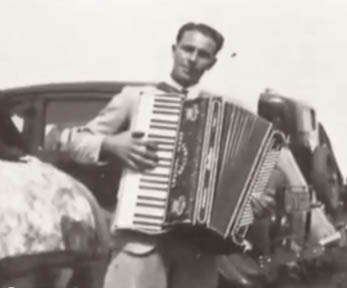 ...
...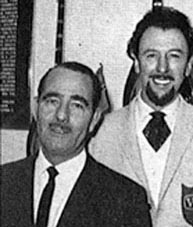
JMI owner Tom Jennings (left) and Tom with Vox engineer Dick Denney (right)
•1950 - Tom Jennings, owner of the Jennings Organ Company, forms Jennings Musical Instruments in 1950. He opens his first retail store, The London Accordion Centre, at 100 Charing Cross Road in London. It would later serve as a retail outlet for Vox products and import brands such as Fender. Supposedly Tom Jennings owned the whole block where the store was located. Jennings had a long history in the keyboard industry, and both he and engineer Larry Underdown are credited as designers of one of the very first synthesizers, the Jennings Univox.
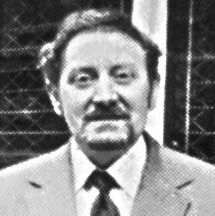
•1956 - Tom Jennings hires Larry Macari as a salesman (Anthony Macari, son of Larry's brother Joe, still posesses the dated letter offering Larry the job). Larry would eventually co-run the Jennings shop at 100 Charing Cross Road with Paul Butchard.
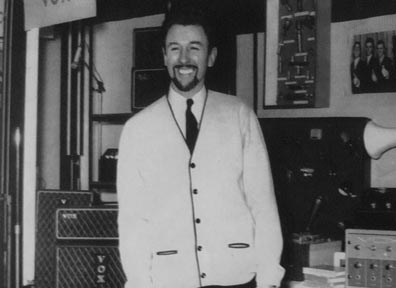
Jennings/Vox engineer Dick Denney
•1957 - Tom Jennings hires his wartime associate Dick Denney (1921-2001) to design a line of Vox amplifiers after hearing one of Denney's hand made amps. Jennings and Denney had worked and played music together at Vickers munitions factory during WWII. The Univox and Vox names were already in use by Jennings for organs. The new amplifier line was to be branded Vox. The first JMI made amps under the Vox brand come to market in 1957. Jennings also incorporated his company into Jennings Musical Industries (JMI) in 1957.
•1957 November - In early November a consortium is formed between JMI (Tom Jennings) ,Thomas Organ (Joe Benaren), and possibly EKO (Ennio Uncini), to work on joint ventures. JMI engineer Dick Denney is involved in these meetings. A new joint factory is set up in Italy to make organs, called EME (Elettronica Musicale Europea, or European Electronic Musical). Engineers from each company are sent to visit the others' factories to get acquainted with production methods. Setting up EME's factory, production, marketing, and retail dealerships spans the next few years. The date EME was in full production is in doubt, but likely by 1964-65. EKO's involvement in the consortium may have come later, since EKO supposedly was not formed until 1959. GEM (Generale Elettro Musica) was also contracted to produce a version of one Vox organ around this time by JMI.
•1958 - Vox AC15 amp released, designed by Vox/JMI engineer Dick Denney. One of the first amps to be branded VOX. The original version of Dick Denneys higher wattage Vox AC-30 also made, against Tom Jennings wishes.
•1960 – The legendary Vox AC30 amp (the AC-30/6 Dick Denney revised version) on market. This amp would later be associated with its famous users, including The Shadows, the Beatles, the Rolling Stones, Brian May of Queen, Tome Petty and Mike Cambell of The Heartbreakers, the Edge of U2, and Peter Buck of R.E.M.
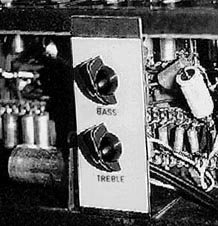
•1961 - In late 1961 (some sources date this to 1960) Vox engineer Dick Denney creates the "Top Boost" add-on for the Vox AC-30/6 amp. The Top Boost was a separate treble and bass booster circuit with an extra gain stage, created to compensate for the undesirable loss of gain and treble from improvements made to the original AC-30 circuit. It was likely the first booster unit in the UK, and Top Boost became a common name for the vast number of treble boosters offered by other makers shortly thereafter. By 1963 it was sold as a separate add on unit, as well as being built into amps. This is the version of the AC-30 the Beatles used on their early recordings. Dick Denney based the Top Boost on the tone circuit from a Fender Twin amplifier. In the November 2009 issue of Guitarist magazine, Vox engineer Gary Hurst states he also worked on the TB with Dick Denney: "There are a lot of stories that remain to be told about that particular circuit, I have to say."
•1960 or '61- Engineer Gary Hurst is hired by Vox/JMI labs in Dartford, England. He is one of five or six engineers working at the lab, along with Dick Denney, Les Hills, Doug MacDonald, Alan Harding, and chief engineer Larry Underdown. He reports to Vox sales manager and idea man, Reg Clark.
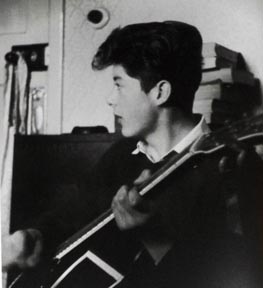 ...
... 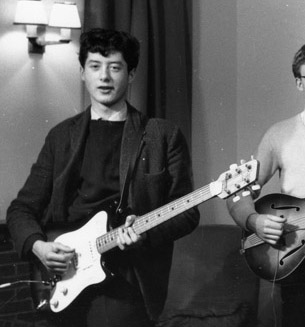 ...
... 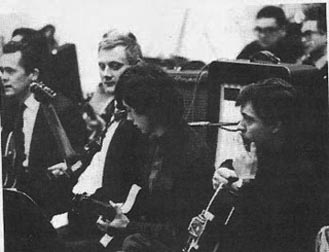
Jimmy Page. Middle photo is when Page played with Malcolm Austin & The Whirlwinds in 1959
•1960 - A young guitarist in south London named Jimmy Page begins playing guitar in a local clubs, while still a student. He plays in several bands and starts doing his first recording session work in 1961 or 1962. Some of his fellow guitarists are Jeff Beck and Eric Clapton.
•1961 - One of the first electronic fuzz box effects (not the first) is built in California by top session guitarists and engineer/amp repairman Orville "Red" Rhodes. One was made for the Ventures in 1962, at their request. This fuzz box would indirectly have an influence on session guitarist Jimmy Page a few years later. Rhodes also made and played many other effects used on Ventures records, including an early vocoder device, as well as recording a few albums under his own name.
•1961 (circa) - Vox engineer Dick Denney states he designed a two-transistor fuzz circuit prototype around 1961. Note that Anthony Macari (of Macari's Musical Instruments) has stated the '1961' year was just a loose date, mentioned by Dick Denney to him over tea one morning. 1961 pre dates the release of the Maestro Fuzz-Tone, so the actual date Denney put this circuit together was probably broadly sometime in the early to mid 1960's, most likely later than 1962. The Colorsound Fuzz Box is similar to the circuit Denney would design for the Rotosound Fuzz in the late 1960's, the fuzz section of the Jennings Growler Fuzz-wah, and used as the basis for the one knob Colorsound Fuzz Box that was released in 1996.
•1962 - Gibson Fuzz-Tone released in the U.S.A. Sometime mid to late 1960 in Nashville, Tennessee, recording session engineer Glen Snoddy is in the studio when an early (not the first) example of electronic fuzz tone is created. A defective pre amp console causes the bass solo recorded for Marty Robbins song Don't Worry, to have a fuzzy sound. The distorted bass is kept for the final recording, and the song became a #1 country hit in 1962. Snoddy saved the console, determined what went wrong, and with friend Revis V. Hobbs (a fellow Tennesseean and engineer with the famous WSM Radio in Nashville) he created a 3-transistor circuit to replicate the bass guitar fuzz tone. Glen Snoddy states (in the book Fuzz and Feedback by Tony Bacon) : “Later when I found out what it was, I set about trying to develop that sound using transistors. We fooled around with it and got the sound like we wanted. I drove up to Chicago and presented it to Mr. Berlin, the boss at the Gibson company, and he heard that it was something different. So they agreed to take it and put it out as a commercial product.”
There were already many hand made fuzz boxes being used in studios at the time, but Gibson became the first to the market with a mass produced consumer fuzz circuit. Glenn Snoddy and Revis Hobbs are credited as the designers on the patent. The first production version of the Fuzz-Tone was built into Gibson bass guitars (first commercial use February 16, 1962), as that was the original intended use. later in 1962 Gibson decided to release it in a stand-alone floor pedal form that other instruments could be plugged into, the Maestro Fuzz-Tone (FZ-1). The FZ-1 is generally accepted as the first production fuzz pedal ever made, however the product was somewhat of a flop as far as sales were concerned. In general, most people were not impressed with it's farty sound, and lack of sustain created by the low powered 3v circuit. Gibson sold nearly all 5000 units produced the first year to dealers. Apparently most sat on shelves unsold, as Gibson sold only a few in 1963. However, people like Frank Zappa were recording with them in 1963, and musicians were soon figuring out that the FZ-1 sounded even more interesting with the electric guitar as it did with bass. There were dozens of not so well known American garage and surf band recordings made using them with the electric guitar in 1963 and 1964, in American states like Michigan, Texas, and California.
•1962 - In America the Ventures use a fuzz box on their song 2000 Pound Bee. The fuzz box was a hand made effect, built in 1961 by Red Rhodes. Jimmy Page, thinking the Ventures used a Maestro Fuzz-Tone for this song, would later ask effects engineer Roger Mayer to make him a fuzz unit to create a similar sound, but with more sustain. Jimmy has often cited this song as one of his favorites, and very influential to his early sound.
•1962 (circa) - JMI/Vox engineer Dick Denney claimed he made a prototype Vox fuzz box based on the Gibson Maestro Fuzz-Tone for Vox, but it is not developed for production. Apparently Tom Jennings had heard the American Maestro Fuzz-Tone (Vox bought one), did not like the effect, and was not interested in producing one. Fuzz-tone was just starting to be used in the US, mostly for county songs, and it was not as popular as it would become a few years later, after the Rolling Stones and the Yardbirds popularized the effect. Denney stated Vox later introduced that fuzz box circuit as the Vox Tone Bender. It was very similar to the MK1.5 Tone Bender, giving the impression in some people's minds the first Vox Tone Bender circuit is possibly Dick Denney's work, or that Denney may be responsible for the odd MK1.5 version of the Tone Bender (1965), which is a very similar 2-transistor circuit (all pure speculation). It is also not clear if the prototype circuit Denney referenced is the same one later developed for the Colorsound Fuzz Box in 1996.
According to Denney, "We had a lot of young people working in our lab, and some of them would knock off our circuits. I think that's why a lot of our early designs like the fuzz were leaked out". Denney claimed a "rogue" employee working for Vox took the schematic for his fuzz and "started making up fuzz-boxes and selling them for himself." (this is reiterated in the AnalogMan Guide to Vintage Effects book by Tom Hughes, the Beatles Gear book by Andy Babiuk, a 2007 Guitar Player article by Art Thompson, and Stombpox by Art Thompson). Since Gary Hurst was working in the JIM/Vox engineering department at the time, left shortly after this, and then started producing a fuzz box based on the American Maestro Fuzz Tone, many have have assumed the "rogue employee" Denney refers to is, in fact, Gary Hurst. The pedals he "started making...and selling for himself" would be the early wood boxed Tone Benders. Denney also stated he used "black Mullard OC77 germanium transistors" in his prototype, which is exactly what was used in the early Gary Hurst Tone Benders. However, Denney is no longer with us, so there is no way to know who he was really talking about. There were several other engineers working at Vox at the time, and a few also left Vox to work for other companies, so it could have been anyone.
In the 2012 BBC documentary Vox Pop - How Dartford Powered the British Beat Boom, Paul James of the Vox Advertising Dept had this to say about the Denney fuzz box: "Dick slumbered into our studio, because he used to sit down on the desk and have a coffee, with this Oxo box (a tin Oxo Cubes box is shown with a small circuit inside, but it appears to be a prop), and he plugged the guitar into this Oxo box and the amplifier, and he played this terrible distortion guitar...and we said Dick, all the years Vox have been trying to get a clean sound and you have devised this racket, and he said 'trust me brov, trust me'. It'l go'. An within four weeks the Rolling Stones were making Satisfaction."
The documentary implies by the way it was edited that the fuzz used on Satisfaction was this Vox fuzz, but it was nothing of the sort. Satisfaction was not released until August 1965 in the UK, and it was recorded using a Maestro Fuzz-tone. It is doubtful Denney was showing off this prototype fuzz box just four weeks prior to Satisfaction being recorded since, according to Denney, he had already delivered protoype Vox fuzz boxes to the Beatles in early 1965, and his Vox Distortion Booster fuzz box was already being shown publicly in August. Perhaps the circuit in the Oxo tin box could have been the One Knob Fuzz circuit described above, or possibly the Vox Distortion Booster circuit, and Paul James simply has forgotten what year he actually saw it.
•1962 - Vox T60 amp head released. Paul McCartney of the Beatles was one of the first users of this amp. The input stage topology resembles the simple 2 transistor circuits, like those that would later be used in the Vox Distortion Booster, Tone Bender MK1.5, Fuzz Face, and Dick Denney Colorsound Fuzz Box. The T60 was primarily a Les Hills design (one of the solid state organ designers), but Dick Denney or Gary Hurst may have been involved since they also worked on Vox amplifier designs.
•1963 January - Reg Clark, sales manager for JMI/Vox, makes an endorsement agreement with Beatles manager Brian Epstien to supply the band two free AC-30 amps with the Top Boost add-on. Epstien promised the Beatles would use them on stage in public, in return for letting Vox use their images free of charge. Tom Jennings was not keen on the idea, since at the time the Beatles were still relatively unknown, other than in Germany. By Summer they would be a very popular and in-demand band in England. By the end of '63 they were the most popular band to ever come out of England. The first Vox ad featuring the Beatles appeared in June 1963. Later the deal expanded that the Beatles would use only Vox amps and keyboards on stage exclusively. The Beatles were initially given this gear free of charge. They reportedly were also later given Vox effect pedals and guitars to use. The Jennings/Vox endorsement was the first of many the band would do with various manufacturers. This arrangement ended around 1967. According to JMI/Vox engineer Dick Denney, many of the improvements to the Vox products and development for new products was inspired by feedback given to them by the Beatles, and their stage needs. Vox engineer Alan Harding (who would later work with the Macaris) was even sent on tour with the Beatles to keep their amps running.
•1963 Summer - The Kinks record You Really Got Me, release August 4, 1964. Although the fuzz tone is not produced with an effects pedal, this song was instrmental in popularizing fuzz tone in the UK, and reached #1 on the UK charts. It also made them one of the leading British invasion bands in America. Producer Shel Talmy used close miking to bring the guitar to the forefront of the mix, an early example of making guitar power chords be dominant in the song, rather than being an equal level or mixed lower than the vocals. The Maestro Fuzz-Tone was ultra rare outside of America at this time, especially in the UK. Kinks guitarist Dave Davies did not have one, but he wanted a dirty fuzz-tone sound, and tried any means to get it. According to Talmy, Dave slashed his guitar speaker cone with a raazor to get the dirty, fuzzy speaker breakup on this song, but part of this sound was also the way it was recorded. The miked guitar signal was split, with one feed heavily compressed, then mixed back together with the other feed in the mixing board.
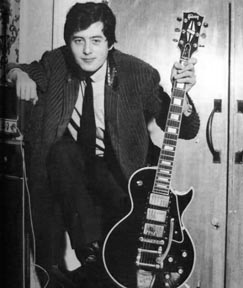
Jimmy Page with his Black Beauty Les Paul, purchased in 1962 and used for his session work from 1963-66 and on tour in 1970-71 until it was stolen in September 1971
Jimmy Page was a young and successful guitarist at this time, often on hand as a professional studio session player, booked to play in place of the actual artist or band guitarist. Many record producers used session musicians, who were quick to learn and play songs accurately, to save money and time in the studio. This was standard procedure in recording studios. Some guitarists simply could not perform effectively in the expensive recording studio environment, due to nervousness and the high stress created by being required to perform perfectly and on cue, in a relatively short time. A few of Jimmy's fellow session guitarists were Jim Sullivan and Vic Flick.
Jimmy had worked as a session player for producer Shel Talmy on numerous ocassions, including several Kinks sessions. Much of what he played was rhythm guitar, or doubling other guitar parts, but on many occasions Jimmy played lead guitar, and often with a fuzz box. Contrary to popular belief, Jimmy Page does not play lead on The Kinks You Really Got Me, although he did play rhythm guitar in place of Ray Davies on the Kinks first album, simply because Ray Davies did not want to play rhythm and sing at the same time. According to producer Larry Page, Jimmy did play the solo for an instrumental version of You Really Got Me, recorded for The Larry Page Orchestra's Kinky Music album in April-May 1965. It is an almost note-for-note replica of the Kink's solo.
•1963 - The Beatles are spending more time in London, now frequenting the music shops around Charing Cross Road and Shaftsbury Street, including the Jennings/Vox shop.
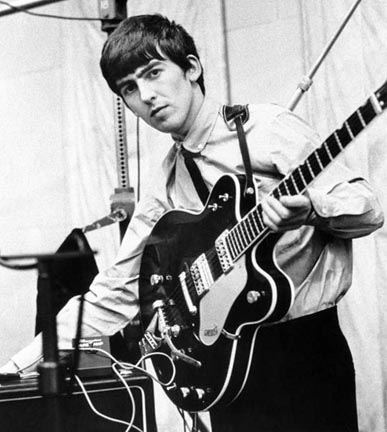 ..
..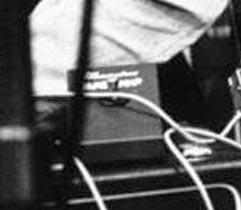 ..
..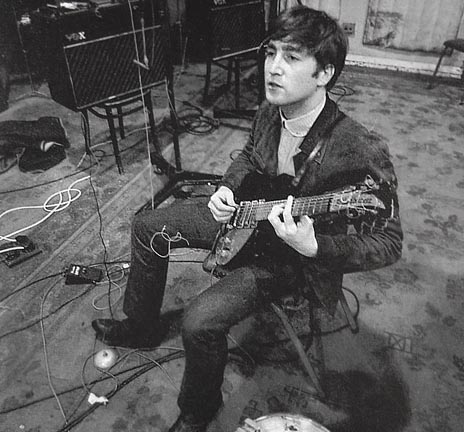
George Harrison and John Lennon using the Maestro Fuzz-Tone in 1963
•1963 - George Harrison is photographed using the Gibson Maestro Fuzz-Tone in the recording studio for the Beatles' She Loves You sessions. John Lennon is also photographed using one for the Don't Bother Me sessions in September. The American made Maestro was a rare and expensive piece of gear in the UK at this time, but fuzz boxes were slowly growing in popularity in the blossoming London music scene. Many young guitarists desired to try one, even though some recording studios, and the BBC, frowned at the use of distortion. The Fuzz-Tone was used experimentaly for several takes, but does not appear in the final mix of either song. This particular unit was reportedly purchased by the Beatles at Selmer's music store on Charing Cross Road, although there are other reports that Harrison bought one in the USA in 1963.
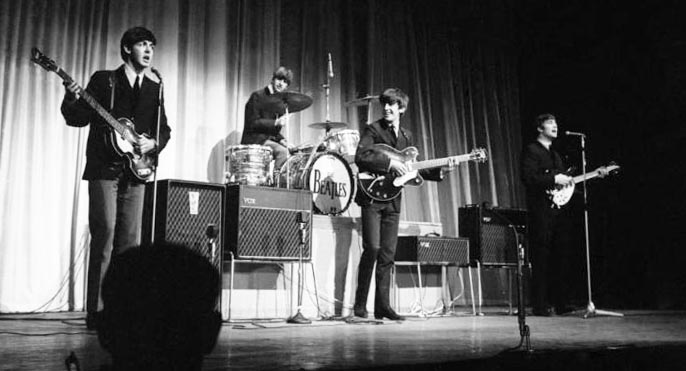
•1963 November - Larry Macari serviced the Beatles' guitars before the famous Royal Command Performance, Prince of Wales Theatre in London, 4 November 1963.
•1963 - Vox/JMI engineer Gary Hurst is moved to the Vox technical and promotions center (Tom Jennings called it the "Laboratory") on New Compton Street, London. This was a promotion center and showroom for all Vox products. According to Gary Hurst, he ran this center, handling visitors, customers, and repairs. Reportedly, Tom Jennings owned a whole floor in this building, just around the corner from his Jennings/Vox shop on 100 Charing Cross Rd, where Larry Macari worked as chief salesman (the Vox shop would later became a Macaris Musical Exchange shop in 1967). Many working musicians, including the Beatles, frequented this shop.
•1963-64 - Tom Jennings, in order to raise capital for JMI's expansion, and pay off debts, sells controlling interest of JMI to military contractors The Royston Group, who were developing a black box recorder for use in airplanes. He also sells American rights for the Vox name to the California-based Thomas Organ Company, who would distribute all Vox amps/organs in the US. Unfortunately the Royston Group would later siphon money from JMI, rather than invest in its expansion.
•1963 or '64 - At this time Larry Macari was chief salesman, running the JMI/Vox shop at 100 Charing Cross Road with Paul Butchard, just around the corner from the Vox laboratory on New Compton Street. Around 1963-64 Larry and his brother Joe open the first musical storefront on Denmark Street, Macaris Musical Exchange (various sources cite other dates). They eventually open three store locations by 1965. Macaris would become the primary outlet for Vox products and JMI exclusive import products, like Fender. The addresses for these first three shops are in MKI Tone Bender advertisements from 1965.
22 Denmark St, London W.C.2.
155 Burnt Oak Broadway, Edgware, Middlesex
46b Ealing Road, Wembley, Middlesex.
•1964 - Vox closes the promotional center on New Compton Street. Gary Hurst resigns (Hurst has stated he left because Vox wanted him to work Saturdays) and moves into a new location, 2 floors above the Macaris Musical Exchange shop on Denmark Street, to run his own business. Although now independent, he continues to do work for JMI/Vox. According to Gary, he was also on call as a fix it man for the Beatles at this time, often called for repairs by their road manager.
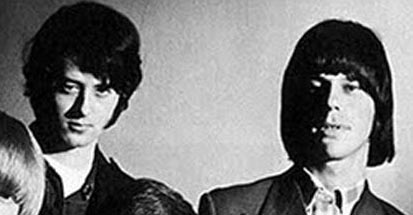
Jimmy Page and Jeff Beck
•1964 October - Fuzz guitar featured on the Screaming Lord Such & the Savages sessions in early 1964 for Draculas Daughter and the B-side Come Back Baby, released in October 1964. Jimmy Page and (disputedly) Jeff Beck played on these London sessions in early 1964, recorded by engineer Joe Meek. This is one of the earliest recordings in the UK using a fuzz box, most likely a Maestro Fuzz-Tone. Many sources claim Beck also played lead on Dracula's Daughter, but just as many say it was actually Savages guitarist Geoff Mew. Beck has stated he does not remember playing on Dracula's Daughter and that he never even met Joe Meek. Note that there are some accounts that completely contradict Jimmy or Jeff being involved in these sessions at all, confusing them for the later 1969 sessions where Page and beck are documented to have played with Screaming Lord Such. Jeff Beck is known to have played in the Savages band on at least one occasion in 1964 at Eel Pie Island, and recorded with Screaming Lord Such in 1969 on the song Gutty Guitar.
BACK TO THE FUZZ AND MUFF TIMELINE
Website and contents ©2007 and ©2014 Kit Rae. All rights reserved. Linking to this website is allowed, but copying the text content is strictly prohibited without prior authorization. No part of this work may be reproduced, stored in a retrieval system, or transmitted in any other form, or by any means, electronic, mechanical, photocopying, recording, computer networking, or otherwise without prior permission in writing from the copyright holder(s).
Kit’s Secret Guitar, Gear, and Music Page
Guitar stuff, gear stuff, sound clips, videos, Gilmour/Pink Floyd stuff, photos and other goodies.
Copyright Kit Rae.
VISIT MY SWORDS, KNIVES and FANTASY ART WEBSITE www.kitrae.net
